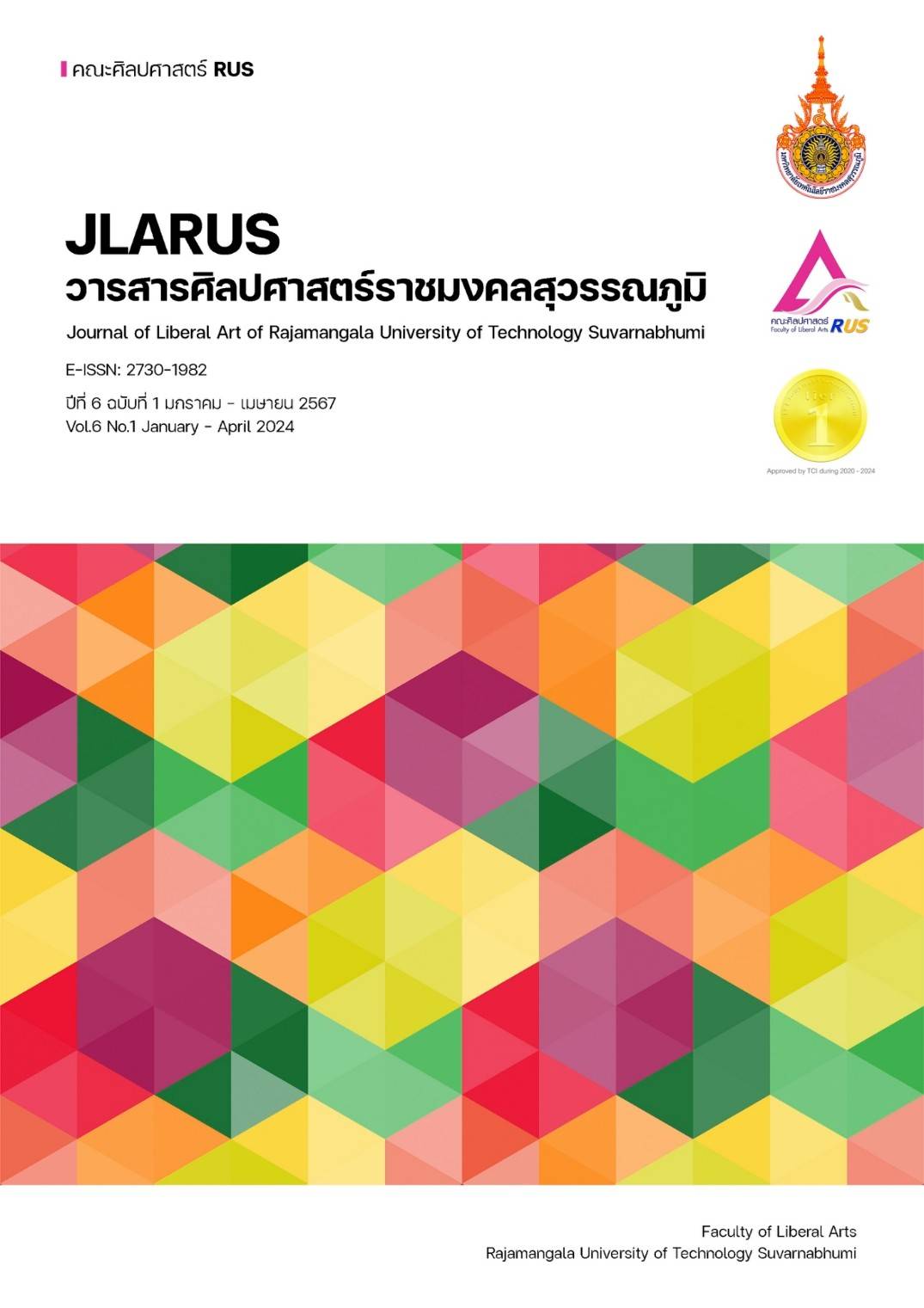A MODEL FOR CURRICULUM DEVELOPMENT OF MUSIC TECHNOLOGY AND SOUND DESIGN IN UNDERGRADUATE INSTITUTIONS OF HIGHER EDUCATION
Main Article Content
Abstract
The objectives of this research were 1) to determine the competencies of students in the curriculum in the music technology and sound design program, 2) to develop a model for curriculum development in the music technology and sound design program with professional competency as the base, 3) to develop a prototype curriculum for the field of music technology and sound design. The research study format used a mixed methods research process, which had the 5-step research method. The tools used in the research included questionnaires and interviewed which collected data from a sample of 200 people.
The research results found that 1) there were 9 competencies of students in the music technology and sound design curriculum that were consistent with the needs of stakeholders. 2) The model for developing the music technology and sound design curriculum had professional competency as a base, consisting of 3 processes: competency and goals, process and performance, and learning and assessment, with a total of 17 steps, with the professional competency base as the goal in developing the curriculum, which had the concept of participation of graduate users as an important focus. 3) Prototype curriculum in music technology and sound design was a model curriculum to develop music technology curricula in higher education institutions with guidelines for setting career goals consistent with student competencies obtained from research and lead to courses that reflected learning outcomes. From the students' competencies, they could lead to the goals of 2 career groups: 1) producer, artist, music production and 2) sound operator, sound engineer, technician in sound system work, and practitioners in sound recording, sound mixing.
Article Details

This work is licensed under a Creative Commons Attribution-NonCommercial-NoDerivatives 4.0 International License.
References
กรภัทร เฉลิมวงศ์ และคณะ. (2566). การพัฒนาหลักสูตรการเรียนการสอนข้ามศาสตร์แบบบูรณาการสมรรถนะ ด้านอิเล็กทรอนิกส์อัจฉริยะเพื่อสร้างนวัตกรรมสำหรับสาขาวิชาช่างอุตสาหกรรม หลักสูตรประกาศนียบัตรวิชาชีพ (ปวช.) สังกัดสำนักงานคณะกรรมการการอาชีวศึกษาในพื้นที่ภาคใต้. วารสารพัฒนาเทคนิคศึกษา มหาวิทยาลัยเทคโนโลยีพระจอมเกล้าพระนครเหนือ, 35(127), 66–78.
กฤษณุชา สรรเสริญ. (2563) แนวทางการพัฒนาสมรรถนะของพนักงานที่ทำงานด้านเทคโนโลยีสารสนเทศในสถานประกอบการประเภทธุรกิจงานบริการด้านโลจิสติกส์ในเขตกรุงเทพมหานคร (วิทยานิพนธ์ปริญญาศึกษาศาสตรมหาบัณฑิต). กรุงเทพมหานคร: มหาวิทยาลัยสุโขทัยธรรมาธิราช.
จีรพัส บทมาตย์ และคณะ. (2566). รูปแบบการพัฒนาหลักสูตรเสริมสร้างสมรรถนะตามมาตรฐานอาชีพแบบไตรภาคี. วารสารสันติศึกษาปริทรรศน์ มจร, 11(3), 1044–1055.
ฐิติมา ญาณะวงษา และคณะ. (2564). หลักสูตรที่เน้นผลลัพธ์: แนวทางใหม่สำหรับหลักสูตรอุดมศึกษา Outcome-Based Curriculum: New approach for Higher Education Curriculum. วารสารมนุษยศาสตร์และสังคมศาสตร์ มหาวิทยาลัยราชภัฏพิบูลสงคราม, 15(2), 279-291.
ทิศนา แขมมณี. (2557). ศาสตร์การสอน : องค์ความรู้เพื่อการจัดกระบวนการเรียนรู้ที่มีประสิทธิภาพ. (พิมพ์ครั้งที่ 18). กรุงเทพมหานคร: สำนักพิมพ์แห่งจุฬาลงกรณ์มหาวิทยาลัย.
ทิศนา แขมมณี. (2562). 10 สมรรถนะหลัก ปั้นเด็กไทยฉลาดรู้..อยู่ดีมีสุข มีความสามารถสูง และใส่ใจสังคม. สืบค้น 30 มกราคม 2564. จาก http://site.ksp.or.th/content.php?site=library&Site MenuID =4472 &Action =view&Sys_Page=&Sys_PageSize=&DataID=2251.
คณะกรรมการมาตรฐานการอุดมศึกษา (2565). ประกาศคณะกรรมการมาตรฐานการอุดมศึกษา เรื่อง เกณฑ์มาตรฐานหลักสูตรระดับปริญญาตรี พ.ศ. 2565, ราชกิจจานุเบกษา. (เล่ม 139 ตอนพิเศษ 212 ง). สืบค้น 16 มกราคม 2566. จาก https://www.ops.go.th/th/ches-downloads/edu-standard/item/6942-2022-07-2203-17-22.
มารุต พัฒผล. (2562). รูปแบบการพัฒนาหลักสูตรร่วมสมัย. สืบค้น 29 สิงหาคม 2563. จาก www.curriculumandlearning.com.
วาสนา กีรติจำเริญ และ อิสรา พลนงค์. (2566) การพัฒนารูปแบบการพัฒนาหลักสูตรในพื้นที่นวัตกรรมการศึกษา สำหรับเสริมสร้างสมรรถนะที่จำเป็นสำหรับนักเรียนในระดับการศึกษาขั้นพื้นฐาน. วารสารราชพฤกษ์, 21(3), 188-202.
สำนักงานคณะกรรมการดิจิทัลเพื่อเศรษฐกิจและสังคมแห่งชาติร่วมกับสถาบันวิจัยเพื่อการพัฒนาประเทศไทย. (2563). รับมือเทคโนโลยีป่วนไทย How Can Thailand Deal with Disruptive Technology ?. กรุงเทพมหานคร: สถาบันวิจัยเพื่อการพัฒนาประเทศไทย.
Bloom, B. S. (1956). Taxonomy of educational objectives: the classification of educational goals. New York: Longmans.
Taba, H. (1962). Curriculum development, theory and practice. New York: Harcourt.
Mctighe, J. & Wiggins. G. (2011). The Understanding by Design® framework. สืบค้น 21 เมษายน 2563. จาก https://www.ascd.org/ASCD/pdf/siteASCD/publications/UbD_WhitePaper0312.pdf.
Yamane, T. (1967). Statistics: An introductory analysis. (2nd Edition). New York: Harper and Row.


